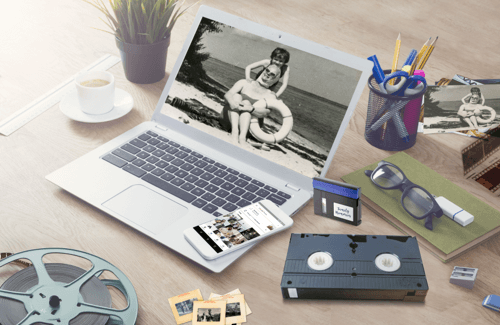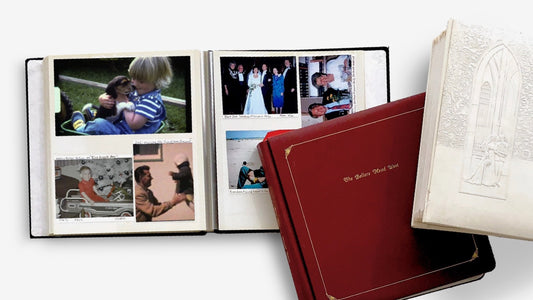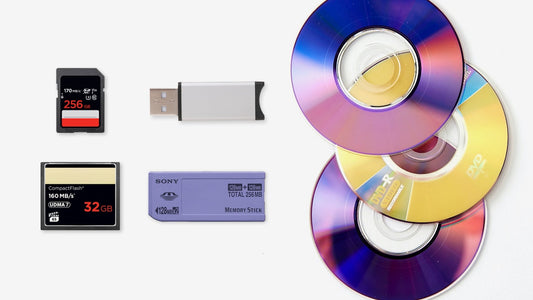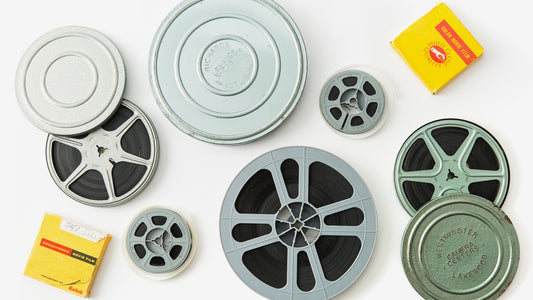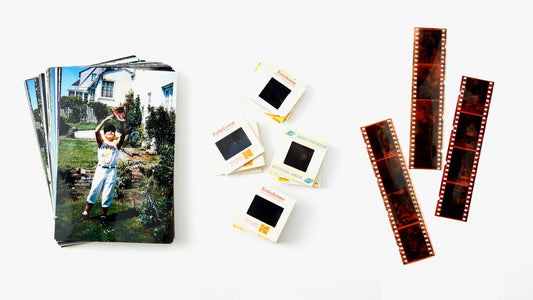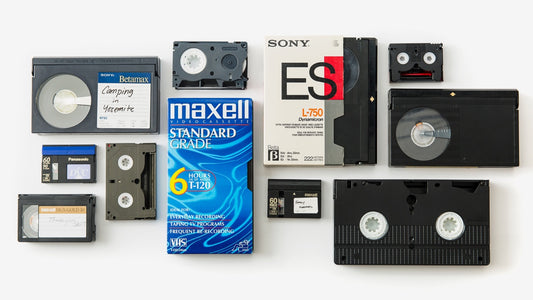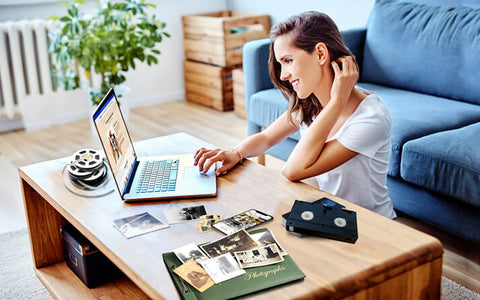Your family slides hold so many precious memories, each with its own unique vintage charm. But as the years go by, those physical images can fade, get damaged, or simply be forgotten in a closet. When you transfer slides to digital, you aren't just scanning pictures; you're actively protecting those moments for good. This guide breaks down all your options for slide digitization. We’ll walk through everything from DIY scanning to professional services, helping you choose the best method for preserving your irreplaceable family history and sharing it for generations to come.
Key Takeaways
- Digitizing slides protects precious memories. Digital formats safeguard against damage, making sharing easy and ensuring accessibility for years to come. Professional services are a great option for large or delicate collections.
- Select the best digitization method. DIY offers control but demands time and equipment. Professional services provide convenience and expertise, ideal for large or damaged sets of slides. Consider image quality, cost, and time when deciding.
- Preparation is key for top-notch results. Cleaning, organizing, and labeling slides beforehand, whether you choose DIY or professional services, ensures high image quality and easy management. Knowing your slide formats and checking for damage will help you choose the right approach.
Why Digitize Your Slides?
Remember those carousel slide projectors and the satisfying click as the next image popped onto the screen? Slides capture moments in time, often featuring family vacations, holidays, and life’s milestones. But those little squares of film are fragile. Over time, they can deteriorate, fade, and become damaged due to heat, humidity, or just the passage of time. Digitizing your slides is like giving them a new lease on life, ensuring those precious memories remain vivid for generations to come. Plus, let’s be honest, who even has a slide projector handy these days?
Digitizing slides offers several key advantages. First, it safeguards your memories against loss or damage. Think of it as creating a backup of your visual history. Once your slides are digital files, you can easily store them on your computer, an external hard drive, or a cloud storage service. This digital preservation protects your memories from physical deterioration and ensures they’re safe even if something happens to the original slides. Services like YesVideo can help with this process.
Second, digitizing makes sharing so much easier. No more lugging out the projector and screen! You can quickly share digital photos via email, social media, or even create online albums for family and friends to enjoy. Imagine sharing vacation photos from decades ago with relatives across the country—with just a few clicks. This ease of sharing helps connect generations and keeps those memories alive and vibrant. Learn more about photo transfer options.
Finally, digital images are simply more accessible. You can view them on your computer, tablet, phone, or even your smart TV. You can also easily organize and search your digital photo collection, making it simple to find specific moments or events. No more sifting through boxes of slides trying to locate that one special picture. Digitizing your slides puts your memories at your fingertips, ready to be enjoyed whenever you want.
How to Transfer Slides to Digital: Your Best Options
You have a few options when it comes to digitizing your slides, each with its own set of pros and cons. Let's break down the best methods, from DIY approaches to professional services.
Going DIY: Using a Scanner or Camera
If you’re comfortable with technology and want hands-on control, digitizing slides yourself can be a rewarding project. You can use a dedicated slide scanner, a flatbed scanner with a transparency adapter, or even photograph your slides with a digital camera or through a slide projector. Each method has its own learning curve. Dedicated slide scanners offer the highest quality but can be an investment. Flatbed scanners are more common and versatile, but the quality might not be as high for slides. Using a camera can be a cost-effective option if you already own one, but getting consistent lighting and focus takes practice. Resources like Fstoppers offer helpful tips for DIY slide digitization. Remember that scanning slides yourself can be time-consuming, especially with a large collection. It takes a few minutes per slide to scan and save, so factor that into your decision.
Using a Smartphone App
For a quick and easy solution, you can turn to your smartphone. Apps like SlideScan are designed to let you digitize slides using your phone's camera. The process is straightforward: you place the slide on a backlit surface (like a tablet screen showing a white image) and use the app to capture the photo. The app then crops and enhances the image for you. While this method is incredibly convenient for quickly sharing a few memories on social media, it's important to know that the quality often doesn't compare to what you'd get from a dedicated scanner. Your phone's camera and the app's processing can only do so much, so this is best for casual use rather than high-quality archival.
Using a Slide Duplicator
If you're a photography enthusiast and already own a DSLR or mirrorless camera, a slide duplicator might be a great option. This handy device attaches to your camera lens and has a slot to hold a single slide. It essentially lets you photograph your slides up close with consistent lighting and alignment. This method gives you much more control over the final image quality than a smartphone app, allowing you to adjust settings like exposure and focus directly on your camera. While it requires more equipment and a bit of setup, using a slide duplicator can produce impressive results, making it a solid middle-ground between a simple app and a professional service for those who enjoy a hands-on approach.
Hiring a Pro: The Pros and Cons
Professional slide scanning services take the hassle out of digitizing your memories. Companies like YesVideo specialize in this process, handling everything from sorting and cleaning your slides to delivering high-resolution digital files. This is a great option if you have many slides or if your slides are delicate or damaged. Professional services often use high-end equipment and software for the best possible image quality, including color correction and dust removal. Memory Fortress points out that some services even allow you to review and label your digital images after they're scanned. Professional services come at a cost, so weigh the convenience and quality against your budget. Not all services handle less common slide formats, so if you have anything beyond standard 35mm slides, check with the company beforehand, as highlighted by Contrastly.
How to Choose the Right Slide Transfer Method
Deciding how to digitize your slides depends on several factors. Weighing these considerations will help you choose the best method for your needs and budget.
Considering Image Quality and Resolution
If you're aiming for top-notch quality, look for methods offering at least 3,000 DPI (dots per inch). This high resolution ensures your digital images are crisp and detailed, perfect for both viewing on screens and making prints. Preserving those precious memories means capturing every detail!
Understanding Resolution: Why More Isn't Always Better
When you start looking into slide scanning, you'll see the term DPI, or "dots per inch," mentioned a lot. Think of it as the level of detail captured from your slide. A higher DPI means a more detailed, sharper digital image that can be enlarged without becoming blurry. For excellent quality that’s great for viewing on screens and making prints, a resolution of at least 3,000 DPI is a good benchmark. This ensures that the fine details in your original photos—from the pattern on a sweater to the twinkle in someone's eye—are preserved beautifully, capturing every nuance of the moment.
However, this is one case where more isn't automatically better. While an ultra-high resolution might sound appealing, it creates massive file sizes that can be difficult to store and share. For most family photos, a resolution that's too high won't offer a noticeable visual improvement, but it will take up a lot more space on your hard drive. The goal is to find the sweet spot between detail and file size. Professional photo transfer services have this down to a science, delivering a resolution that captures stunning detail without creating unmanageable files for you to handle.
Choosing the Right File Format: TIF vs. JPG
Once your slides are scanned, they need to be saved as a specific file type. The two most common formats you’ll encounter are TIF and JPG (sometimes called JPEG). A JPG is the format you’re probably most familiar with; it’s used by most digital cameras and smartphones. JPGs are compressed to create smaller files, which makes them perfect for sharing online, sending in an email, or posting on social media. The trade-off is that a tiny bit of image data is lost during this compression, though for most viewing purposes, the difference is practically invisible to the naked eye.
On the other hand, TIF is a "lossless" format, meaning it saves every single bit of image data from the scan. This makes it the gold standard for archival purposes and for anyone who plans to do extensive photo editing later on. The downside is that TIF files are much larger than JPGs, taking up significantly more storage space. A simple way to decide is to follow the advice of pro archivists: save files as TIF for long-term storage and editing, and as JPG for everyday sharing. For most families, a high-quality JPG provides the perfect balance of quality and convenience for enjoying and sharing memories.
Weighing the Cost and Overall Value
Digitizing slides comes with a price tag, whether you do it yourself or hire a pro. Professional slide scanning services can be surprisingly affordable, often starting around 42¢ per slide, with potential bulk discounts. If you're considering DIY, factor in the cost of equipment and software.
How Much Time Do You Really Have?
Time is a valuable commodity. Think about how much time you're willing to invest in this project. DIY scanning can be time-consuming, taking several minutes per slide. If you have a large collection, this can quickly add up. Professional services typically have a turnaround time of 7–10 business days, freeing up your time.
How Many Slides Are You Digitizing?
The number of slides you need to digitize plays a significant role in your decision. DIY might be manageable for a small collection. However, if you're dealing with hundreds or even thousands of slides, a professional service is likely more efficient.
Do Your Slides Need Restoration?
Old slides can suffer from dust, scratches, and color fading. If your slides need some TLC, consider a professional service. They often have trained restoration specialists who can revitalize damaged images. DIY restoration can be tricky and may require specialized software.
How to Digitize Slides at Home: A Step-by-Step Guide
Want to convert slides to digital images yourself? It's totally doable, but fair warning: it's a detailed process. If you’re not already a photo expert, you might find it a bit tricky. This section walks you through the steps, helping you decide if it’s the right path for you.
What You'll Need to Get Started
First things first, you'll need the right tools. You have a few options for digitizing slides at home: a dedicated slide scanner, a flatbed scanner with a transparency adapter, a digital camera, or even photos taken from a slide projector. Each method has its pros and cons, so consider what's most important to you: speed, image quality, or cost. Dedicated slide scanners generally offer the best quality but can be an investment. Flatbed scanners are a good middle ground, while using a camera or projector requires more setup and effort. If you choose to use your camera, you'll need a tripod and consistent lighting. Using a projector requires a screen and precise focus.
Your Step-by-Step Scanning Guide
Once you've got your equipment, it's time to start scanning. No matter which method you choose, be prepared for this to take time. Even with a scanner, creating a digital copy of each individual slide can take several minutes to scan and save. If you have hundreds of slides, this can quickly become a significant time commitment. Experts estimate at least two to three minutes per slide. And that doesn't include the time to handle each slide carefully, position it correctly, and ensure it's free of dust or debris. Using a camera or projector adds extra steps, like setting up the shot and transferring files.
Pro Tip: Using White Paper with a Flatbed Scanner
If you're using a flatbed scanner to digitize your slides, here’s a simple trick that can make a real difference. Place a sheet of glossy white paper underneath the slides before you scan. This little step might seem minor, but it significantly improves the results by creating a reflective surface that helps with lighting and captures more detail from the film. To get the best possible image, also make sure you choose the right settings on your scanner, like selecting "positive film" and a high resolution. While this technique helps, keep in mind that most flatbed scanners can't match the quality of a dedicated film scanner or a professional service, but it's a great way to get better results from the equipment you have at home.
How to Edit and Organize Your Digital Files
After scanning, you'll likely want to edit and organize your new digital images. This might include color correction, cropping, or removing dust spots. There are many photo editing software options available, from free programs like Google Photos to professional software like Adobe Photoshop. Choose the software that best suits your needs and technical skills. Once your images are edited, think about how you want to organize them. Creating folders by date, event, or subject can make it easier to find and share your memories later. Some people prefer to label each image individually, which can be time-consuming but helpful for future reference. You can also add tags or descriptions to your files to make them even more searchable. Services like YesVideo handle this entire process for you, from scanning and editing to organizing and preserving your photos, which can be a huge time saver if you have a large collection or limited time.
Professional Slide Transfer: What to Expect
Thinking about handing your precious memories over to a slide scanning service? It’s natural to want to know what will happen to them. Here’s a look at what you can typically expect when you use a professional slide transfer service:
How the Professional Process Works
Most services follow a similar process. You’ll typically package your slides and ship them to the company. Some companies, like Legacybox, send you a welcome kit with everything you need, including a prepaid shipping label. Others may require you to use your own packaging. Either way, be sure to package your slides carefully to prevent damage during transit. Once the company receives your slides, they'll scan them at high resolution, converting them into digital image files. You’ll then receive your digitized photos back on a DVD, USB drive, or via a digital download, depending on the service and the options you choose. It’s important to choose a company that handles all processing in-house, ensuring your slides don't leave their secure facility. For example, Nostalgic Media emphasizes its in-house processing as a key feature.
The Mail-In Kit System
Most professional services simplify the process with a mail-in kit. For example, a company like YesVideo will send you a crush-proof box with everything you need to safely pack and ship your slides. This system is designed to make turning your old photos and home movies into digital files as straightforward as possible. You simply fill the box with your slides, apply the prepaid shipping label, and send it off. It removes the guesswork and provides a secure way to transport your memories, ensuring they are protected on their journey to be digitized for easy viewing and sharing for years to come.
Communication and Order Tracking
It’s completely understandable to feel a little nervous about sending your one-of-a-kind slides through the mail. Reputable companies get this, which is why they offer robust tracking and communication. Many services use special barcodes to track your order from the moment it leaves your hands until it’s safely returned. You can often follow the progress online with real-time updates, giving you peace of mind. Some companies even offer a guarantee for your package. As an extra layer of security, your digital files are often backed up for a period after your order is complete, just in case.
How You'll Receive Your Digital Files
Once the digitization process is complete, you’ll get all your original slides back, along with your brand-new digital copies. You typically have a few choices for how you receive your digital files. Common options include a convenient USB thumb drive, a DVD set, or access to your memories through a secure cloud account. This flexibility allows you to choose the format that works best for you. A USB is great for plugging directly into a computer or smart TV, while cloud storage makes it incredibly easy to share your photos with family and friends anywhere in the world.
Common Service Limitations
While professional services are incredibly convenient, it’s good to know about a few common limitations. For instance, most companies can’t guarantee they will keep your slides in the exact order you sent them. The good news is that once your images are digital, organizing them into folders on your computer is simple. Another thing to check is the type of slides the service accepts. Most handle standard 35mm slides, but if you have less common formats, it’s always a good idea to confirm with the company beforehand to ensure they can process your entire collection.
How Long Will It Take?
How long you’ll wait to see your digitized slides depends on the company and the size of your order. Some services offer a quick turnaround time, often completing orders within 7–10 business days. Nostalgic Media is known for its relatively fast turnaround. Others have a standard turnaround time of 10–12 weeks. Legacybox, for instance, falls into this timeframe. If you're in a hurry, some companies offer expedited processing for an additional fee. Be sure to factor turnaround time into your decision, especially if you need your digital images by a specific date.
Standard vs. Expedited Processing Times
When you send your slides to a professional service, you'll usually have a choice between standard and expedited processing. Standard processing is the more budget-friendly option, but it requires patience. Turnaround times can range from a few weeks to as long as 10–12 weeks, depending on the company and how busy they are. If you’re not in a hurry, this is a great way to save some money. However, if you need your digitized slides for an upcoming birthday, anniversary, or holiday gift, you’ll want to consider expedited processing. This premium service costs extra but significantly cuts down the wait time, often getting your digital files back to you in about two weeks or less. When choosing a photo transfer service, be sure to check their estimated turnaround times for both options so you can pick the one that best fits your schedule and budget.
Ensuring You Get High-Quality Scans
When choosing a professional service, look for quality assurance measures. A reputable service will use high-resolution scanning, typically around 3,200 DPI, which is suitable for both viewing and printing. Many services also offer color correction to improve faded or discolored slides. Check if the company offers a satisfaction guarantee or a refund policy if you’re not happy with the results. Nostalgic Media, for example, offers a 100% satisfaction guarantee. Some companies provide a guarantee against loss or damage during shipping, like the $1,000 guarantee offered by Legacybox. A 30-day on-site backup of your digital files is another good sign that the company takes data preservation seriously.
DIY vs. Pro: A Full Cost Breakdown
When deciding how to digitize your slides, weighing the costs of DIY versus professional services is key. Let's break down the expenses involved in each approach.
Breaking Down the Costs of DIY
The DIY route might seem cheaper upfront, but hidden costs can add up. If you're digitizing slides yourself, you'll need equipment. This could involve purchasing a dedicated slide scanner, adapting a flatbed scanner, or using a digital camera with a macro lens. Slide scanners range from around $80 to upwards of $500, while decent flatbed scanners with slide scanning capabilities start around $100. If you're using a camera, factor in the cost of a macro lens and tripod, which can add another $100–$300 or more to your expenses.
Beyond equipment, consider the time investment. Scanning slides can be time-consuming, taking several minutes per slide. Think about the value of your time and whether you’d rather spend it on other priorities. Also, factor in potential software costs for editing and organizing your digital images.
How Professional Services Are Priced
Professional slide transfer services offer convenience and expertise. Companies like YesVideo handle the entire process, from carefully handling your slides to delivering high-quality digital files. Pricing for these services varies. Some companies, like Nostalgic Media, charge per slide, with prices starting as low as $0.42 per slide (with minimum order requirements). Others, like Legacybox, offer tiered pricing based on the number of items you want to digitize. Research different providers to compare pricing and services to find the best fit for your needs and budget. Don't forget to factor in shipping costs, which can vary depending on the company and your location.
Common Pricing Models: Per-Slide vs. Tiered Kits
When you explore professional services, you'll generally find two main pricing structures: per-slide or tiered kits. The per-slide model is straightforward—you pay a set price for each slide you send in. This can be very affordable, with some services charging as little as 42¢ per slide, and it's a great option if you know exactly how many slides you have. The other common model is a tiered kit, like the ones offered by Legacybox. With this approach, you purchase a kit that accommodates a certain number of items, which can be a mix of slides, photos, or even videotapes. This is perfect if you have a variety of media to digitize and want a simple, all-in-one price. Counting your slides beforehand can help you decide which model offers the best value for your collection.
Potential Extra Fees to Watch For
It’s always smart to read the fine print to understand the full cost. The advertised per-slide price might not cover everything. For instance, some companies charge extra for slides that are housed in metal holders or plastic sleeves—sometimes an additional 20 cents per slide. You can often avoid this fee by removing them yourself before shipping. Other potential fees could include charges for specific slide formats or advanced color correction. At YesVideo, we believe in transparent pricing, so you know exactly what you’re paying for. Always check what’s included in the base price to avoid any surprises when the final bill arrives. This helps ensure your budget stays on track while you preserve your precious memories.
Factoring in Shipping Costs
Shipping is a crucial part of the process when you’re sending irreplaceable memories through the mail. The cost can vary depending on the company, your location, and the size of your collection. Many services, including ours, provide a crush-proof, pre-paid shipping box to make the process as safe and simple as possible. Look for a service that offers order tracking so you can follow your slides on their journey. Some companies also provide a guarantee against loss or damage for extra peace of mind, like the $1,000 guarantee offered by Legacybox. Entrusting your memories to a trusted service that prioritizes security from start to finish is essential, ensuring your slides arrive safely for digitization and are returned to you along with your new digital copies.
Our Top Picks for Professional Slide Transfer
Finding the right slide transfer service depends on your needs and budget. Let's take a look at some popular options, from professional services to DIY equipment providers.
YesVideo
YesVideo stands out with over two decades of experience in preserving family memories. As the largest and most trusted transfer service worldwide, they handle all orders by hand in the USA, focusing on quality and providing a service families can rely on. Check out their slide transfer services for a professional, hands-off approach.
A Focus on Quality and Trust
When you're handing over irreplaceable family slides, trust is everything. You want to know your memories are in safe hands. YesVideo understands this deeply, which is why every single order is processed by hand, right here in the USA. This commitment means your precious slides aren't shipped overseas; they're cared for by trained technicians dedicated to quality. This hands-on approach ensures each slide is treated with respect. With over 20 years of experience, YesVideo has perfected its photo transfer process to deliver clear, vibrant digital images that you can easily share and enjoy. They provide a secure way to preserve your family's legacy, giving you peace of mind and beautiful digital keepsakes that will last for generations.
Nostalgic Media
Nostalgic Media offers slide scanning at a high resolution (3200 DPI), turning your physical slides into crisp digital images. With a 7–10 business day turnaround and a satisfaction guarantee, they prioritize quality and customer happiness. Learn more about their slide scanning service.
Legacybox
Legacybox specializes in digitizing 35mm slides, using color correction to enhance your images. They offer various digital delivery formats, including thumb drives and cloud storage. While standard processing takes 10–12 weeks, they provide a comprehensive solution for preserving your memories. Explore their slide scanning services for more details.
Walgreens
For a convenient option, Walgreens offers in-store digitization of slides, photos, and home movies. They handle the entire process, accepting a wide range of formats, with prices starting at $29.99. Find a location near you and learn more on the Walgreens photo website.
Pricing and Delivery Details
When you’re ready to choose a service, it’s helpful to compare pricing and delivery details. For instance, Nostalgic Media offers competitive pricing at around 42¢ per slide and promises a quick 7–10 business day turnaround. If time isn't a major concern, Legacybox provides a comprehensive service that includes color correction, though their standard processing takes about 10–12 weeks. For a convenient, hands-on option, Walgreens offers in-store digitization starting at $29.99. At YesVideo, we provide a secure, all-inclusive experience with our prepaid mail-in kits, where every slide is processed by hand in the USA to ensure the highest quality. Your choice will ultimately depend on your budget, how many slides you have, and how quickly you want your digital memories back.
ScanMyPhotos
ScanMyPhotos provides bulk slide scanning services, making it a good choice for large collections. They offer a variety of digital formats to ensure high-quality images. See what ScanMyPhotos can do for your slide collection.
DigMyPics
DigMyPics focuses on digitizing slides, negatives, and photos with an emphasis on quality and customer satisfaction. Their straightforward process makes it easy to send in your materials for conversion. Visit the DigMyPics website to learn more.
Kodak
If you prefer a DIY approach, Kodak offers slide scanners for home use. Their user-friendly devices provide high-resolution scans, giving you control over the digitization process.
Epson
Epson offers flatbed scanners equipped to handle slides and negatives. Known for high resolution and dust removal features, these scanners are a solid choice for at-home digitization.
Common Slide Scanning Problems (and How to Solve Them)
Converting slides to digital files offers a fantastic way to preserve your memories, but the process presents a few common hurdles. Let's explore these challenges and how you can overcome them, ensuring your digitized images look their best.
Dealing with Dust and Scratches
Dust and scratches are almost inevitable with slides that have been stored for a while. These imperfections can significantly impact the quality of your digital images. While DIY scanning might seem appealing, it can be time-consuming and may not deliver the desired results. Tiny dust particles become magnified during the scanning process, and attempting to remove scratches from physical slides yourself can cause irreversible damage. Professional slide scanning services often use specialized equipment and techniques to minimize the appearance of dust and scratches during digitization.
Using Digital ICE Technology
One of the best tools for tackling dust and scratches is Digital ICE (Image Correction and Enhancement) technology. Think of it as a magic eraser for your slides. This clever feature, found in many high-end scanners, uses infrared light to automatically spot and remove imperfections from the scanned image. The best part? It does all this without ever physically touching or altering your original slides, keeping them safe. This means you get a much cleaner, clearer digital photo that truly honors the original memory.
Many professional services, including our team at YesVideo, use advanced technology to ensure your digitized images are as pristine as possible. When you're researching professional options, it's a great idea to ask if they use Digital ICE or a similar dust and scratch removal technology. As Memory Fortress notes, this feature is an invaluable tool for getting high-quality results. It can make a huge difference in the final quality of your digital keepsakes, ensuring they look their absolute best.
Bringing Faded Colors Back to Life
Over time, the colors in your slides can fade or shift. Color correction is often necessary to restore the original look of your photos. This can be a complex process, especially if slides have been affected by mold or other damage. A trained restoration specialist can rebuild images and correct color issues, ensuring your memories are preserved accurately. Professional services often include color correction as part of their slide digitization packages.
How to Organize a Large Collection of Slides
If you have a substantial slide collection, organization can be a major challenge. Thousands of slides can be difficult to manage, especially when trying to identify people, places, and events. Consider how you want to organize your digital images before you begin scanning. Some services allow you to label digital images individually after the initial transfer, as discussed in this helpful resource on digitizing old slides. This can be more efficient than sorting and labeling each physical slide beforehand. You can then organize your digital files into folders, add tags, and create albums with ease.
How to Store and Share Your Newly Digitized Slides
After digitizing your slides, preserving and sharing those memories is the next step. Let's explore some smart strategies for storage, sharing, and creating lasting digital keepsakes.
Choosing the Best Digital Storage
Think about how you want to access your newly digitized photos in the future. Cloud storage offers convenient access from anywhere, while physical media like DVDs and USB drives provide a tangible backup. Services like Legacybox offer a variety of digital and physical options, giving you flexibility. Nostalgic Media also provides several delivery methods, so you can choose what works best. Consider a combination of both for the most secure archiving.
Easy Ways to Share with Family and Friends
Sharing your digitized memories should be easy and enjoyable. YesVideo's photo transfer service creates high-quality digital files perfect for sharing online or through email and social media. For sharing physical copies, services like Walgreens offer DVD and USB drive formats.
Creating Digital Albums and Slideshows
Organizing your digitized slides into albums adds another layer of enjoyment. Creating digital albums yourself can be a fun project. If you’d rather not spend the time, consider professional services. Memory Fortress offers helpful advice on digitizing slides. For a DIY approach, try a two-step scanning method. An online photography forum suggests an initial lower-resolution scan of all slides, followed by high-resolution scans of your favorites using a DSLR camera or other high-quality equipment. This balances efficiency with capturing the best images in detail.
Prepare Your Slides for Digitization: Best Practices
Getting your slides ready for digitization ensures you’ll get the best possible images. A little prep work goes a long way! Here’s how to prepare your slides for either DIY scanning or professional digitization services:
How to Clean Slides Without Damaging Them
Dust, fingerprints, and debris can significantly impact the quality of your digital images. Before scanning, carefully clean each slide with a soft, lint-free cloth or use a blower to remove loose particles. Avoid harsh chemicals or abrasive materials that could scratch the slide's surface. For stubborn debris, a gentle cleaning solution designed for film can be used sparingly.
Essential Cleaning Tools
To get the best quality images, you need to start with clean slides. The right tools are simple but essential. You’ll want a can of compressed air or a manual air blower to gently remove loose dust and debris without touching the slide's surface. For fingerprints or smudges, a soft, lint-free microfiber cloth is your best friend. It’s important to use a cloth specifically designed for lenses or film to avoid leaving behind tiny fibers or causing scratches. These basic tools will help you prepare your slides for scanning, ensuring the final digital images are as clear as possible. If dealing with delicate or heavily soiled slides feels daunting, remember that professional services like YesVideo include cleaning as part of their process.
A Gentle Cleaning Method
When it comes to cleaning, a gentle touch is everything. Start by holding the slide by its edges to avoid adding new fingerprints. Use your air blower to puff away any loose dust first. This step is crucial because wiping a dusty slide can drag particles across the surface and create scratches. If you still see smudges, gently wipe the slide with your lint-free cloth in a straight line from the center to the edge. Avoid circular motions, which can create swirl marks. As our own photo slides guide mentions, you should never use harsh chemicals or abrasive materials, as they can permanently damage the film emulsion. The goal is to carefully clean each slide, not to scrub it.
Organize and Label to Make Things Easier
Sorting your slides beforehand streamlines the entire digitization process. Organize them chronologically, by event, or any system that makes sense for your collection. Labeling each slide or group of slides with descriptive names will make it much easier to locate specific images after they're digitized. Consider using archival-quality pens and labels to avoid damaging the slides.
A Note on Preserving Slide Order
If you have a specific story you want your slides to tell—like a chronological vacation or a wedding day—it's a good idea to organize them before sending them off. Many services can't guarantee they'll keep individual slides in the exact sequence, so taking charge of the order beforehand is your best bet. The easiest way to do this is to sort your slides into numbered groups. This simple step helps ensure your story stays intact from the physical slide to the digital file.
Organizing your slides beforehand also helps streamline the entire digitization process, making it smoother for everyone. Even if the order isn't perfect after scanning, don't worry. Once your slides are digitized, you have complete freedom to rearrange and organize the image files on your computer. In fact, some people find it more efficient to label the digital images after the transfer, rather than labeling every single physical slide beforehand.
Do You Know Your Slide Format?
Familiarize yourself with the different slide formats you have. While 35mm slides are common, other less common formats might require specific handling or equipment. Knowing your slide types helps you choose the right scanning method and settings, whether you're using a flatbed scanner, a dedicated slide scanner, or opting for a professional service.
Beyond 35mm: Other Common Formats
While 35mm slides are the most recognizable format, you might discover other types in your family’s collection. It’s not uncommon to find smaller 110 and 126 slides, or even larger 120 medium format and large format slides, which capture a greater level of detail. Some collections even contain unique formats like 3D/Stereo slides. Identifying what you have is an important step, as not all scanners or services can handle every type. Before you commit to a DIY method or a professional service, it’s a good idea to confirm they can process your specific formats. A comprehensive guide on slide formats can help you identify what you're working with. For peace of mind, especially with varied or rare formats, choosing an experienced photo transfer service ensures your entire collection is handled with care.
Inspect for Damage and Decide on Restoration
If your slides are old or have been stored improperly, carefully inspect them for any signs of mold, mildew, or damage. For severely damaged slides, consult a professional for restoration before digitization. This can help salvage precious memories that might otherwise be lost. Proper storage after digitization is also crucial.
Choosing the Right Equipment for DIY Scanning
If you're digitizing slides yourself, invest in the right equipment. A dedicated slide scanner or a flatbed scanner with a transparency adapter will generally produce the best results. These devices are specifically designed to handle the nuances of slide scanning, capturing sharp, high-resolution images. Research different models and read reviews to find the best scanner for your needs and budget.
How to Safely Pack Your Slides for Shipping
If you're sending your slides to a professional service, packing them securely is the most important step to protect your memories during transit. Let's make sure they arrive safely. First, choose a sturdy box that’s not too big or too small. You want to prevent the slides from shifting around too much. Use plenty of cushioning material like bubble wrap or crumpled newspaper to fill any empty space. If your slides are already in carousels or trays, you can often send them just as they are. For loose slides, it's a great idea to group them in Ziploc bags to keep them organized and protected. Many professional services, including our team at YesVideo, provide detailed instructions to guide you, and some even send a special shipping kit to make the process foolproof. Taking a few extra minutes to pack carefully gives you peace of mind that your precious history is in good hands.
Related Articles
- Photo Slides: A Comprehensive Guide (2023) – YesVideo
- Top 6 Photo Scanning Services to Preserve Your Memories – YesVideo
- Cassette to Digital: Your Ultimate Conversion Guide – YesVideo
- Convert VHS to Digital: The Ultimate 2024 Guide – YesVideo
- 8mm to DVD: Top Conversion Services & DIY Guide – YesVideo
Frequently Asked Questions
Why should I digitize my old slides? Digitizing slides protects them from damage and deterioration over time. It also makes them much easier to share with family and friends, no matter where they live. Plus, you can easily access and view your digital photos on any device, without needing a slide projector.
What's the best way to digitize slides? The best method depends on your needs and budget. You can digitize slides yourself using a scanner or camera, or use a professional service. DIY offers more control but can be time-consuming. Professional services are convenient but come at a cost. Consider your comfort level with technology, the number of slides you have, and your budget when making your decision.
What are the key factors to consider when choosing a slide digitization method? Consider image quality and resolution, the overall cost, the time and effort involved, the volume of slides you have, and whether your slides need restoration or enhancement. Balancing these factors will help you find the best approach for your situation.
What should I expect if I use a professional slide transfer service? Typically, you'll send your slides to the company, they'll scan them at high resolution, and return your digitized photos on a DVD, USB drive, or via digital download. Turnaround times vary, so check with the specific service. Look for quality assurance measures like high-resolution scanning and color correction.
How can I prepare my slides for digitization? Gently clean your slides with a soft, lint-free cloth or blower. Organize and label them for easy tracking after they're digitized. Identify your slide formats to ensure compatibility with your chosen digitization method. Check for any damage and consider professional restoration if needed. If you're scanning yourself, choose the right equipment for your needs and budget.




